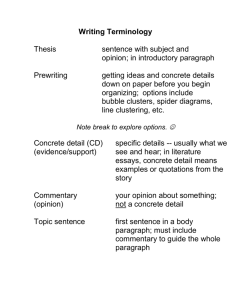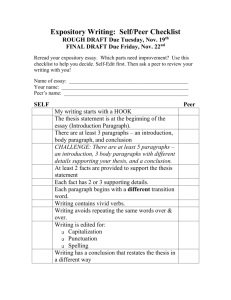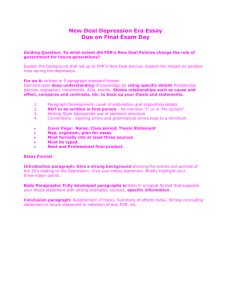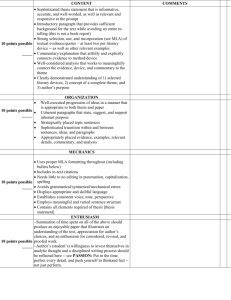Parts of Essay-Introduction-Body Paragraphs etc..doc
advertisement
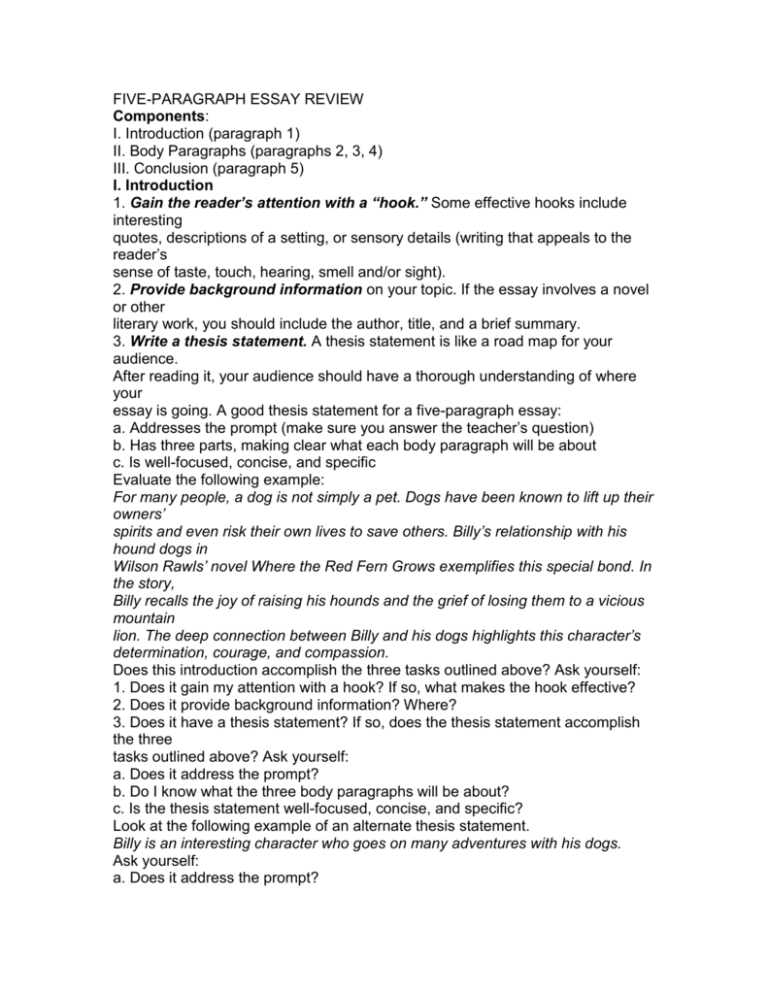
FIVE-PARAGRAPH ESSAY REVIEW Components: I. Introduction (paragraph 1) II. Body Paragraphs (paragraphs 2, 3, 4) III. Conclusion (paragraph 5) I. Introduction 1. Gain the reader’s attention with a “hook.” Some effective hooks include interesting quotes, descriptions of a setting, or sensory details (writing that appeals to the reader’s sense of taste, touch, hearing, smell and/or sight). 2. Provide background information on your topic. If the essay involves a novel or other literary work, you should include the author, title, and a brief summary. 3. Write a thesis statement. A thesis statement is like a road map for your audience. After reading it, your audience should have a thorough understanding of where your essay is going. A good thesis statement for a five-paragraph essay: a. Addresses the prompt (make sure you answer the teacher’s question) b. Has three parts, making clear what each body paragraph will be about c. Is well-focused, concise, and specific Evaluate the following example: For many people, a dog is not simply a pet. Dogs have been known to lift up their owners’ spirits and even risk their own lives to save others. Billy’s relationship with his hound dogs in Wilson Rawls’ novel Where the Red Fern Grows exemplifies this special bond. In the story, Billy recalls the joy of raising his hounds and the grief of losing them to a vicious mountain lion. The deep connection between Billy and his dogs highlights this character’s determination, courage, and compassion. Does this introduction accomplish the three tasks outlined above? Ask yourself: 1. Does it gain my attention with a hook? If so, what makes the hook effective? 2. Does it provide background information? Where? 3. Does it have a thesis statement? If so, does the thesis statement accomplish the three tasks outlined above? Ask yourself: a. Does it address the prompt? b. Do I know what the three body paragraphs will be about? c. Is the thesis statement well-focused, concise, and specific? Look at the following example of an alternate thesis statement. Billy is an interesting character who goes on many adventures with his dogs. Ask yourself: a. Does it address the prompt? b. Do I know what the three body paragraphs will be about? c. Is the thesis statement well-focused, concise, and specific? II. Body Paragraphs The body of the essay is where the ideas introduced in the thesis are developed; each of the three body paragraphs supports one of the three parts of the thesis statement. You should think of each body paragraph like a “mini essay.” Each one has a topic sentence (like the introduction/thesis statement), three concrete details with evidence to support that sentence (like the three body paragraphs), and a “clincher” (like the conclusion). This is how each body paragraph should be structured: Topic Sentence (include a transition) Concrete Detail #1 Commentary #1 Transition Concrete Detail #2 Commentary #2 Transition Concrete Detail #3 Commentary #3 Clincher Topic Sentence Usually the first sentence Includes a transition (optional in body paragraph 1) States the main idea and controls the focus of the paragraph Is more general than the concrete details that follow Concrete Detail Evidence that supports the topic sentence’s main idea It can be an occurrence, description, definition, exploration, or example If the essay is about a literary work, the concrete should include– or be– a direct quote from the work Either way, the detail must be specific Note: you must give your detail context and/or background and weave your quotes (don’t just plop them in) Commentary The analysis or interpretation of the concrete detail Explains how and why the concrete detail supports the topic sentence Transition A word, phrase or sentence that logically connects the first concrete detail/commentary pair to the next concrete detail/commentary pair Should also be used in the topic sentences to connect one body paragraph to the next Examples include: furthermore, in addition to, also, and moreover (see your Transitional Expressions sheet for more examples) Clincher The closing sentence, which wraps up the main idea III. Conclusion 1. Restate the thesis 2. Go beyond the thesis by adding something worthwhile and creative. You could: a. Reach a judgment b. Endorse or oppose an issue (not applicable for all assignments) c. Discuss findings d. Offer an explanation or insight based on your findings e. Tie in or elaborate on your hook f. Bring relevance to the topic by relating it to the world at large A Note on Organization and Order: The three parts of your thesis must be in the same order as the corresponding body paragraphs. For example, in the essay that follows this thesis statement… The deep connection between Billy and his dogs highlights this character’s determination, courage, and compassion. …the first body paragraph must discuss Billy’s determination, the second, his courage, and the third, his compassion. If you change the order while writing your body paragraphs, do not forget to go back and change the order in your thesis, as well; the two must correspond. Good ways to order the three parts include: 1. Chronological 2. Cause, then effect 3. Least important to most important 4. Simplest to most complicated How would you order the three parts in these example theses? Why? 1. Through his friendship with Leslie, Jess discovers his… sharp intelligence sensitivity and kindness artistic talent 2. The view that one should not judge a book by its cover is supported by… Americans’ initial view of Native Americans the novel To Kill a Mockingbird (a personal experience) 3. The theme of using one’s inner strength to triumph over hardship is displayed in… Meg’s rescuing of Charles Wallace acceptance of her father’s weakness realization of her own strengths Using Startling Facts or Statistics as a Grabber - Examples Sometimes a statistic or fact will add emphasis or interest to your essay, and help you to assert a strong voice. A surprising or unusual fact makes your readers curious. They can't wait to read on. When using this technique, it is sometimes a good idea to include the source of your information. In the following examples, notice how the surprising facts have been used grab the reader's interest. Back to Step 6: Write the Introduction


